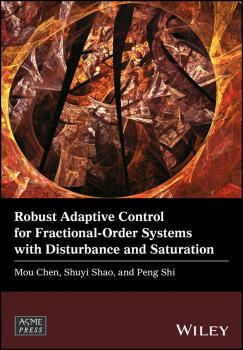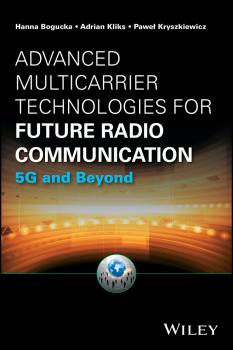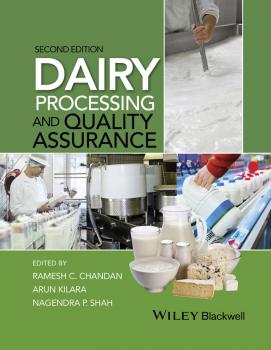Техническая литература
Различные книги в жанре Техническая литератураRobust Adaptive Control for Fractional-Order Systems with Disturbance and Saturation
A treatise on investigating tracking control and synchronization control of fractional-order nonlinear systems with system uncertainties, external disturbance, and input saturation Robust Adaptive Control for Fractional-Order Systems, with Disturbance and Saturation provides the reader with a good understanding on how to achieve tracking control and synchronization control of fractional-order nonlinear systems with system uncertainties, external disturbance, and input saturation. Although some texts have touched upon control of fractional-order systems, the issues of input saturation and disturbances have rarely been considered together. This book offers chapter coverage of fractional calculus and fractional-order systems; fractional-order PID controller and fractional-order disturbance observer; design of fractional-order controllers for nonlinear chaotic systems and some applications; sliding mode control for fractional-order nonlinear systems based on disturbance observer; disturbance observer based neural control for an uncertain fractional-order rotational mechanical system; adaptive neural tracking control for uncertain fractional-order chaotic systems subject to input saturation and disturbance; stabilization control of continuous-time fractional positive systems based on disturbance observer; sliding mode synchronization control for fractional-order chaotic systems with disturbance; and more. Based on the approximation ability of the neural network (NN), the adaptive neural control schemes are reported for uncertain fractional-order nonlinear systems Covers the disturbance estimation techniques that have been developed to alleviate the restriction faced by traditional feedforward control and reject the effect of external disturbances for uncertain fractional-order nonlinear systems By combining the NN with the disturbance observer, the disturbance observer based adaptive neural control schemes have been studied for uncertain fractional-order nonlinear systems with unknown disturbances Considers, together, the issue of input saturation and the disturbance for the control of fractional-order nonlinear systems in the present of system uncertainty, external disturbance, and input saturation Robust Adaptive Control for Fractional-Order Systems, with Disturbance and Saturation can be used as a reference for the academic research on fractional-order nonlinear systems or used in Ph.D. study of control theory and engineering.
Advanced Multicarrier Technologies for Future Radio Communication. 5G and Beyond
A practical review of state-of-the-art non-contiguous multicarrier technologies that are revolutionizing how data is transmitted, received, and processed This book addresses the advantages and the limitations of modern multicarrier technologies and how to meet the challenges they pose using non-contiguous multicarrier technologies and novel algorithms that enhance spectral efficiency, interference robustness, and reception performance. It explores techniques using non-contiguous subcarriers which allow for flexible spectrum aggregation while achieving high spectral efficiency and flexible transmission and reception at lower OSI layers. These include non-contiguous orthogonal frequency division multiplexing (NC-OFDM), its enhanced version, non-contiguous filter-bank-based multicarrier (NC-FBMC), and generalized multicarrier. Following an overview of current multicarrier technologies for radio communication, the authors examine particular properties of these technologies that allow for more efficient usage within key directions of 5G. They examine the principles of NC-OFDM and discuss efficient transmitter and receiver design. They present the principles of FBMC modulation and discuss key challenges for FBMC communications while comparing performance results with traditional OFDM. They move on from there to a fascinating discussion of GMC modulation within which they clearly demonstrate how that technology encompasses all of the advantages of previously discussed techniques, as well as all imaginable multi- and single-carrier waveforms. Addresses the problems and limitations of current multicarrier technologies (OFDM) Describes innovative techniques using non-contiguous multicarrier waveforms as well as filter-band based and generalized multicarrier waveforms Provides a thorough review of the practical limitations and solutions for evolving and breakthrough 5G communication technologies Explores the future outlook for non-contiguous multicarrier technologies as regards their greater industrial realization, hardware practicality, and other challenges Advanced Multicarrier Technologies for Future Radio Communication: 5G and Beyondis an indispensable working resource fortelecommunication engineers, researchers and academics, as well as graduate and post-graduate students of telecommunications. At the same time, it provides a fascinating look at the shape of things to come for telecommunication industry executives, telecom operators, regulators, policy makers, and economists.
Advances in Food Science and Nutrition, Volume 2
Advances in Food Science and Nutrition covers topics such as food safety objectives, risk assessment, quality assurance and control, good manufacturing practices, food processing systems, design and control, and rapid methods of analysis and detection, as well as sensor technology, environmental control, and safety. The thirteen chapters are written by prominent researchers from industry, academia, and government/private research laboratories around the world. The book details many of the recent technical research accomplishments in the areas food science, including: • Potato production, composition, and starch processing • Milk and different types of milk products • Processing and preservation of meat, poultry, and seafood • Food ingredients including additives and natural plant-based ingredients • Fruits and fruit processing • Antioxidant activity of phytochemicals and their method of analysis • The effect of food processing on bioactive compounds • Food safety regulations including foodborne pathogens, probiotics, genetically modified foods, and bioavailability of nutrients • Trends in sensory characterization of food products • Ultrasound applications in food technology • Transformations of food flavor including aroma compounds and chemical reactions that influence flavor • Storage technologies for fresh fruits
Advanced Computational Materials Modeling. From Classical to Multi-Scale Techniques
With its discussion of strategies for modeling complex materials using new numerical techniques, mainly those based on the finite element method, this monograph covers a range of topics including computational plasticity, multi-scale formulations, optimization and parameter identification, damage mechanics and nonlinear finite elements.
From Prognostics and Health Systems Management to Predictive Maintenance 1. Monitoring and Prognostics
This book addresses the steps needed to monitor health assessment systems and the anticipation of their failures: choice and location of sensors, data acquisition and processing, health assessment and prediction of the duration of residual useful life. The digital revolution and mechatronics foreshadowed the advent of the 4.0 industry where equipment has the ability to communicate. The ubiquity of sensors (300,000 sensors in the new generations of aircraft) produces a flood of data requiring us to give meaning to information and leads to the need for efficient processing and a relevant interpretation. The process of traceability and capitalization of data is a key element in the context of the evolution of the maintenance towards predictive strategies.
Classical and Modern Approaches in the Theory of Mechanisms
Classical and Modern Approaches in the Theory of Mechanisms is a study of mechanisms in the broadest sense, covering the theoretical background of mechanisms, their structures and components, the planar and spatial analysis of mechanisms, motion transmission, and technical approaches to kinematics, mechanical systems, and machine dynamics. In addition to classical approaches, the book presents two new methods: the analytic-assisted method using Turbo Pascal calculation programs, and the graphic-assisted method, outlining the steps required for the development of graphic constructions using AutoCAD; the applications of these methods are illustrated with examples. Aimed at students of mechanical engineering, and engineers designing and developing mechanisms in their own fields, this book provides a useful overview of classical theories, and modern approaches to the practical and creative application of mechanisms, in seeking solutions to increasingly complex problems.
MOS Devices for Low-Voltage and Low-Energy Applications
Helps readers understand the physics behind MOS devices for low-voltage and low-energy applications Based on timely published and unpublished work written by expert authors Discusses various promising MOS devices applicable to low-energy environmental and biomedical uses Describes the physical effects (quantum, tunneling) of MOS devices Demonstrates the performance of devices, helping readers to choose right devices applicable to an industrial or consumer environment Addresses some Ge-based devices and other compound-material-based devices for high-frequency applications and future development of high performance devices. «Seemingly innocuous everyday devices such as smartphones, tablets and services such as on-line gaming or internet keyword searches consume vast amounts of energy. Even when in standby mode, all these devices consume energy. The upcoming 'Internet of Things' (IoT) is expected to deploy 60 billion electronic devices spread out in our homes, cars and cities. Britain is already consuming up to 16 per cent of all its power through internet use and this rate is doubling every four years. According to The UK's Daily Mail May (2015), if usage rates continue, all of Britain's power supply could be consumed by internet use in just 20 years. In 2013, U.S. data centers consumed an estimated 91 billion kilowatt-hours of electricity, corresponding to the power generated by seventeen 1000-megawatt nuclear power plants. Data center electricity consumption is projected to increase to roughly 140 billion kilowatt-hours annually by 2020, the equivalent annual output of 50 nuclear power plants.» —Natural Resources Defense Council, USA, Feb. 2015 All these examples stress the urgent need for developing electronic devices that consume as little energy as possible. The book “MOS Devices for Low-Voltage and Low-Energy Applications” explores the different transistor options that can be utilized to achieve that goal. It describes in detail the physics and performance of transistors that can be operated at low voltage and consume little power, such as subthreshold operation in bulk transistors, fully depleted SOI devices, tunnel FETs, multigate and gate-all-around MOSFETs. Examples of low-energy circuits making use of these devices are given as well. «The book MOS Devices for Low-Voltage and Low-Energy Applications is a good reference for graduate students, researchers, semiconductor and electrical engineers who will design the electronic systems of tomorrow.» —Dr. Jean-Pierre Colinge, Taiwan Semiconductor Manufacturing Company (TSMC) «The authors present a creative way to show how different MOS devices can be used for low-voltage and low-power applications. They start with Bulk MOSFET, following with SOI MOSFET, FinFET, gate-all-around MOSFET, Tunnel-FET and others. It is presented the physics behind the devices, models, simulations, experimental results and applications. This book is interesting for researchers, graduate and undergraduate students. The low-energy field is an important topic for integrated circuits in the future and none can stay out of this.» —Prof. Joao A. Martino, University of Sao Paulo, Brazil
Dairy Processing and Quality Assurance
Dairy Processing and Quality Assurance, Second Edition describes the processing and manufacturing stages of market milk and major dairy products, from the receipt of raw materials to the packaging of the products, including the quality assurance aspects. The book begins with an overview of the dairy industry, dairy production and consumption trends. Next are discussions related to chemical, physical and functional properties of milk; microbiological considerations involved in milk processing; regulatory compliance; transportation to processing plants; and the ingredients used in manufacture of dairy products. The main section of the book is dedicated to processing and production of fluid milk products; cultured milk including yogurt; butter and spreads; cheese; evaporated and condensed milk; dry milks; whey and whey products; ice cream and frozen desserts; chilled dairy desserts; nutrition and health; sensory evaluation; new product development strategies; packaging systems; non-thermal preservation technologies; safety and quality management systems; and dairy laboratory analytical techniques. This fully revised and updated edition highlights the developments which have taken place in the dairy industry since 2008. The book notably includes: New regulatory developments The latest market trends New processing developments, particularly with regard to yogurt and cheese products Functional aspects of probiotics, prebiotics and synbiotics A new chapter on the sensory evaluation of dairy products Intended for professionals in the dairy industry, Dairy Processing and Quality Assurance, Second Edition, will also appeal to researchers, educators and students of dairy science for its contemporary information and experience-based applications.
Fringe Pattern Analysis for Optical Metrology. Theory, Algorithms, and Applications
The main objective of this book is to present the basic theoretical principles and practical applications for the classical interferometric techniques and the most advanced methods in the field of modern fringe pattern analysis applied to optical metrology. A major novelty of this work is the presentation of a unified theoretical framework based on the Fourier description of phase shifting interferometry using the Frequency Transfer Function (FTF) along with the theory of Stochastic Process for the straightforward analysis and synthesis of phase shifting algorithms with desired properties such as spectral response, detuning and signal-to-noise robustness, harmonic rejection, etc.
Computer Vision and Imaging in Intelligent Transportation Systems
Acts as single source reference providing readers with an overview of how computer vision can contribute to the different applications in the field of road transportation This book presents a survey of computer vision techniques related to three key broad problems in the roadway transportation domain: safety, efficiency, and law enforcement. The individual chapters present significant applications within those problem domains, each presented in a tutorial manner, describing the motivation for and benefits of the application, and a description of the state of the art. Key features: Surveys the applications of computer vision techniques to road transportation system for the purposes of improving safety and efficiency and to assist law enforcement. Offers a timely discussion as computer vision is reaching a point of being useful in the field of transportation systems. Available as an enhanced eBook with video demonstrations to further explain the concepts discussed in the book, as well as links to publically available software and data sets for testing and algorithm development. The book will benefit the many researchers, engineers and practitioners of computer vision, digital imaging, automotive and civil engineering working in intelligent transportation systems. Given the breadth of topics covered, the text will present the reader with new and yet unconceived possibilities for application within their communities.









